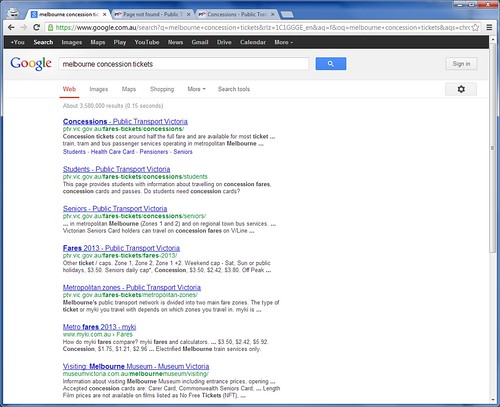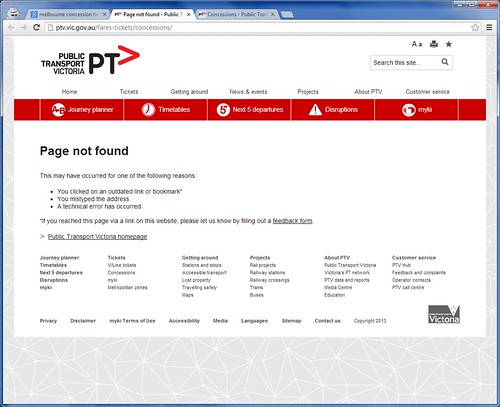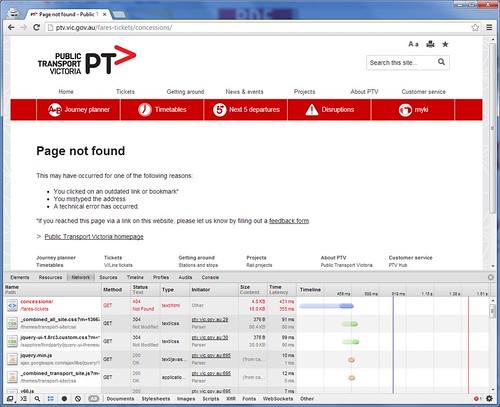On 21 April 2013 Public Transport Victoria launched their new public transport information website, saying in their press release:
The website has been redesigned to make it quicker and easier for you to access the information you need.
However they missed one big item in the move to the new website – redirecting each of their old URLs to the relevant page on the new website. I came across the issue while using Google to find information relating to concession tickets.
The first search result from Google was to this URL:
http://www.ptv.vic.gov.au/fares-tickets/concessions/
Which when clicked on lead me to a useless error page:
After a bit of clicking around on the new PTV website, I finally found the page I was originally supposed to land on:
Note the URL up in my browser bar:
http://www.ptv.vic.gov.au/tickets/concessions/
The only difference between the old and the new URLs is one word in the middle, where the ‘fares-tickets’ portion on the old has been replaced by ‘tickets’ on the new one. Nothing else!
I touched on the issue of website migrations leaving a legacy of broken links a few months ago, when I encountered a similar issue with the Fairfax ‘Metro Media Publishing’ newspaper websites.
In the case of Public Transport Victoria, they have done two things wrong:
- When they moved their website, PTV didn’t bother to keep the URLs the same between the new and the old systems.
- If keeping the old URLs was not possible, then PTV should have set up redirects to the new URL, to ensure any links already out on the internet continue to work after the move was complete.
So when will all of the broken links disappear from Google Search? The ‘page not found’ page on the PTV website returns a correct ‘HTTP 404’ status code, so in time Google will purge the bad links from their database, and replace them with the correct links when they next crawl the website.
All this messing around, all because someone decided to change ‘fares-tickets’ to just ‘tickets’!





I don’t understand when companies do redesigns and change URLs. As Tim Berners-Lee said, “cool URLs don’t change”. There’s no logical reason to change “fares-ticket” to just “tickets”. Sure, it looks nicer, but there’s no advantage to it.
That and it’d be really easy to do 301 redirects. When I’ve redesigned sites in the past and have HAD to change URLS, I’ve always put 301 redirects on all the URLs. My current blog has 301 redirects for old URLs (/year/month/day/slug to /year/month/slug), changed it a few years ago but the redirects are still there.
Spot on there about the redirects – with all the effort one puts into a new website, it isn’t that hard to make sure all of the old links continue to work.
If the PTV website was running on a old Microsoft IIS server what they have done might be understandable, but it appears it is running on Apache, which means adding a few redirects in the .htaccess file is dead simple.
It is not just broken links that are a problem. The whole website is a shocker. Post from me about it coming soon.
Sometimes websites are improved by replacing all the URLs that have 50 characters of gobbledegook (that was perfectly legible to the geek who assigned the URL) with plain language URLs e.g. http://www.porkers.com/pigs/smallpigs/babypigs. This is good SEO practice. Google likes simple descriptive URLs.
A few years ago, DSE, who’s website was administered by DPI for some reason, did just that but likewise failed to provide redirects.
A website I run had dozens of DSE links and they were all broken overnight.
I was able to monitor DSE web traffic and it crashed from 80k+ hits per day to about 12k almost overnight. I corresponded but got nowhere and the enourmous amount of DSE links on websites stayed broken. You can still find them now…
DSE took quite a long time to get their traffic back
Meatheads
Love your work Mr Wong
I’ve had to deal with migrating website URLs a few times myself.
The first time was on my other website (https://www.railgeelong.com/) when I replaced the ugly looking ‘locations.php?id=1234’ links with much nicer ones like ‘/location/geelong’.
My other move was when I spun off my Hong Kong articles onto a separate blog on a new domain (http://www.checkerboardhill.com/). Luckily I control both servers, so I was able to redirect the old URLs across to the new one, with the new site getting all of the incoming traffic via Google from day one.